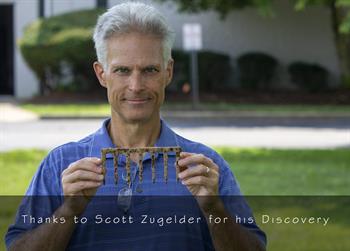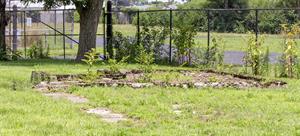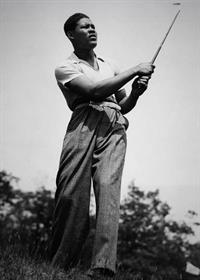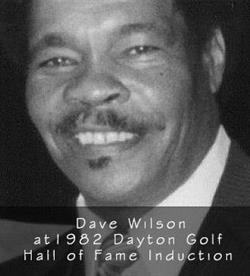The rusty end of a rake.
Most would discard it as junk, but Scott Zugelder didn’t. The old piece of rake isn’t the kind of treasure anyone looks for with a metal detector. But he wanted to know the story behind the unimpressive piece of metal. And while the head of the rake isn’t complete, and the picture of what it represents has gaps, it recalls a treasured past of fractured memories that not many are left to talk about. Zugelder found the rake in a peaceful grassy area next to where he has worked for 22 years: Miami Industrial Trucks on River Road in Moraine. The commercial and industrial area tucked between Interstate 75 and the Miami River used to be home to Miami View Golf Course. The city-owned course opened in 1929 and was the golf home of Dayton’s black community for 33 years. When I-75 construction reached that area in 1963, Miami View’s 9-hole, par-35 course disappeared. The discoveryZugelder began metal detecting about five years ago. In the summer of 2020, his hobby became a lunchtime activity. He’s found a 1911 penny, mercury dimes and sprinkler heads. But this story begins on a summer day in 2021 when he dug up the rake. He had heard a golf course used to exist in the area. “I never really thought about it until I found the rake,” he said. “And then the lady from the office pointed out the tee box. I’ve walked over the dumb thing 100 times – that’s a tee box. And I talked to an older guy, and he kind of filled in the blanks.” On the north side of Zugelder’s office building, in the shade of an old tree, is an elevated area that used to be a tee box. Most likely the tee shot would have been hit east toward 75 or north along the road, but without a map of the old course it’s impossible to know.  Moving north there are the remnants of two greens and what’s left of a stone foundation of an old building. These are between the old Walther building and River Road. From this area, you can look across the road and see the Miami River. Moving north there are the remnants of two greens and what’s left of a stone foundation of an old building. These are between the old Walther building and River Road. From this area, you can look across the road and see the Miami River.
The foundation lies just a little north of the tee box, and beyond that is one of the greens. You know it was a green because of the sloped elevation around what would have been its sides and back side. It’s possible that the visible tee box and this green were part of the same hole. But if the building remnants were part of the golf course, then that wouldn’t be the case because it sits in the middle of what would have been the fairway. About halfway between the tee box and the aforementioned green, is a second green closer to the Walther building and 75. That’s all that can be seen. Zugelder said he’s been told there are visible remains on the east side of 75, but he hasn’t found them. “I'd love to know more,” he said. “How long it was open for, and who all played here, and kind of the culture at the time?” Miami View’s heyday
(The following highlights were culled from Dayton Daily News archives)Miami View was operated by the Linden Community Center and was part of the culture for Dayton’s black citizens. The course (which also included a clubhouse and tennis court) hosted a Decoration Day tournament, blind par tournaments, flag tournaments, poker tournaments, invitationals, club championships, team matches of locals playing out-of-towners, caddy championships and turkey dinners. The club was also home to the prestigious women’s group of the 1950s known as the Golferetts. In 1932, some Sunday morning golfers witnessed two young men die in a plane crash on the grounds of the nearby Miami View camp on East River Road. The sputtering plane engine attracted the golfers’ attention. They watched the plane circle at 50 to 100 feet above the ground as if planning to land. Then the plane began to climb as the engine stopped sputtering. But the engine began missing again, went into a sideslip, struck a telephone wire, and the right wing and nose crashed into the ground. Charles Harding Jr. of Miamisburg and Reuben Fink of Franklin were killed. Capt. James E. Deaton was one of the club’s first and most important members. He shot 84 on Labor Day in 1933 to win the first club championship. A week later Deaton won an invitational at the club with an 88 in a field of 41 golfers. No idea what the course record was, but in May of 1934 it was noted that Warren Robinson toured the nine twice to shoot a 1-under par 69 in a blind par tournament. In February of 1936, Deaton was returning home from a meeting at the club when he was killed in a car wreck on Patterson Boulevard. In October of that year, the first James E. Deaton Memorial tournament was played at the club. Robert Nelson was the first winner with a gross score of 95 and a net of 66. Wilberforce University’s first golf team made history at Miami View in 1937 when it played and defeated Ohio Northern in two matches. It was the first time white and black college teams competed. One match was played at Miami View.  The course was owned by the city, but in 1939 more than half the membership adopted a constitution and by-laws and appointed various standing committees. The first officers: William Jones, president; Mrs. Leo Williamson, vice president; Cal Crawford, secretary; Edgar Nickerson, treasurer, and Robert Mallory and Joe Riffe, members at large. Heavyweight boxing champion and Sgt. Joe Louis made his first appearance at Miami View in August of 1945. He enlisted in the Army in 1942 and was on furlough when he competed in the second annual Miami View Open. Louis returned in 1949. He was out of the Army, retired from boxing and new in the business of being a fight promoter. The tournament opened with 18 holes at Miami View on Saturday and concluded with 36 holes at Community on Sunday. The event attracted 85 players (pros, amateurs, women), according to publicity chairman Raymond “Ducky” Swan. Louis shot an opening-round 78 at Miami View and was doomed by what was reported as a “sour putter.” An estimated crowd of 300 to 500 “dogged his heels all afternoon.” When play ended Sunday at Community, Louis’ secretary, Leonard Reed of Los Angeles, was the amateur champion with a 54-hole total of 228. But everyone was there to see Louis. The gallery exceeded 1,000 following Louis and Reed’s foursome on Sunday at Community. Cars were parked on both sides of Dorothy Lane when the ex-champ began his second 18. He finished fifth among amateurs with a total of 235. In July of 1954, the city raised rates for annual memberships at the three city courses: $40 to play at Madden and Community, which were interchangeable, and $20 at Miami View, which was up from $13 the previous year. Green fees increased to 75 cents and $1 on weekends and holidays at Miami View. This was expected to raise golf revenue for the city by $33,404. The previous year the city was $18,900 in the red, and the 1954 budget was headed for $20,000 projected loss. In September of 1955, Miami View memberships extended to Madden and Community for the remainder of the season because the greens were overcome by hot and humid weather, fungus and crab grass. The policy remained until the Miami View greens were repaired, which was expected to be through the end of the season.  Three-time city champ David “Skinny” Wilson got his start at Miami View. He caddied there for Joe Louis as an eighth grader and bought a set of clubs on the following Monday for $50. He came back from the Air Force in 1956 and wanted to join a group at Miami View. They didn’t want to take his money, so they sent him away. Well, he practiced, came back and beat everybody. Three-time city champ David “Skinny” Wilson got his start at Miami View. He caddied there for Joe Louis as an eighth grader and bought a set of clubs on the following Monday for $50. He came back from the Air Force in 1956 and wanted to join a group at Miami View. They didn’t want to take his money, so they sent him away. Well, he practiced, came back and beat everybody.
Closing dayThe Dayton Daily News headline on Nov. 25, 1962: Today Finale For Golf At Miami View. After 33 years, the last rounds would be played. Three months later it was reported that rounds played at the city’s four courses – Community, Madden, Miami View and Kittyhawk – increased by 47,000 in 1962. Previously, the average boost was 12,000. The biggest increase was seen at Kittyhawk by 40,000. Play at Miami View decreased by almost 4,000. In April of 1963, Dayton Daily News reader E.F.G. of Edgemoor Lane wrote golf writer Ben Garlikov with a question. Since the course had closed, news came out that the section of I-75 that would run through the course probably wouldn’t be completed for another three years. E.F.G. wondered why the course couldn’t stay open until possibly the end of the 1965 season. Garlikov said he had been told if city officials had known sooner, the course could have remained open longer. But fairway sod had already been transplanted elsewhere and the city no longer owned the land. The city received $175,000 for the 14 acres of Miami View that were required for the I-75 project. Parks and Recreation Superintendent John J. Somers said $133,000 would go into the city’s golf fund. The other $42,000 went to the water department. The remaining acres that made up the 53-acre course were later sold at public auction. Miami View was history. | 

 Moving north there are the remnants of two greens and what’s left of a stone foundation of an old building. These are between the old Walther building and River Road. From this area, you can look across the road and see the Miami River.
Moving north there are the remnants of two greens and what’s left of a stone foundation of an old building. These are between the old Walther building and River Road. From this area, you can look across the road and see the Miami River. Three-time city champ David “Skinny” Wilson got his start at Miami View. He caddied there for Joe Louis as an eighth grader and bought a set of clubs on the following Monday for $50. He came back from the Air Force in 1956 and wanted to join a group at Miami View. They didn’t want to take his money, so they sent him away. Well, he practiced, came back and beat everybody.
Three-time city champ David “Skinny” Wilson got his start at Miami View. He caddied there for Joe Louis as an eighth grader and bought a set of clubs on the following Monday for $50. He came back from the Air Force in 1956 and wanted to join a group at Miami View. They didn’t want to take his money, so they sent him away. Well, he practiced, came back and beat everybody.